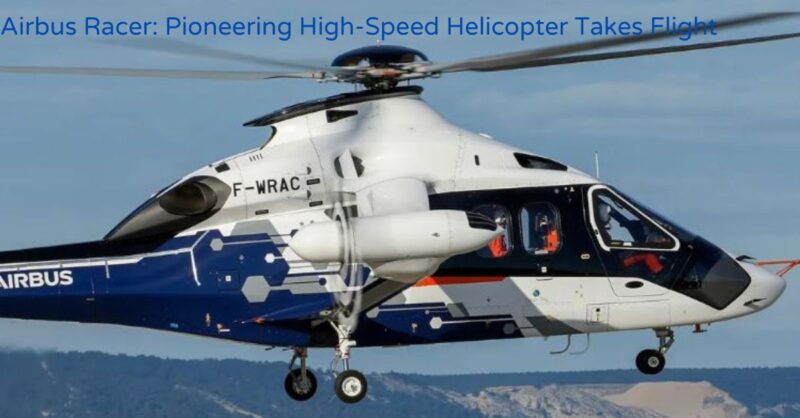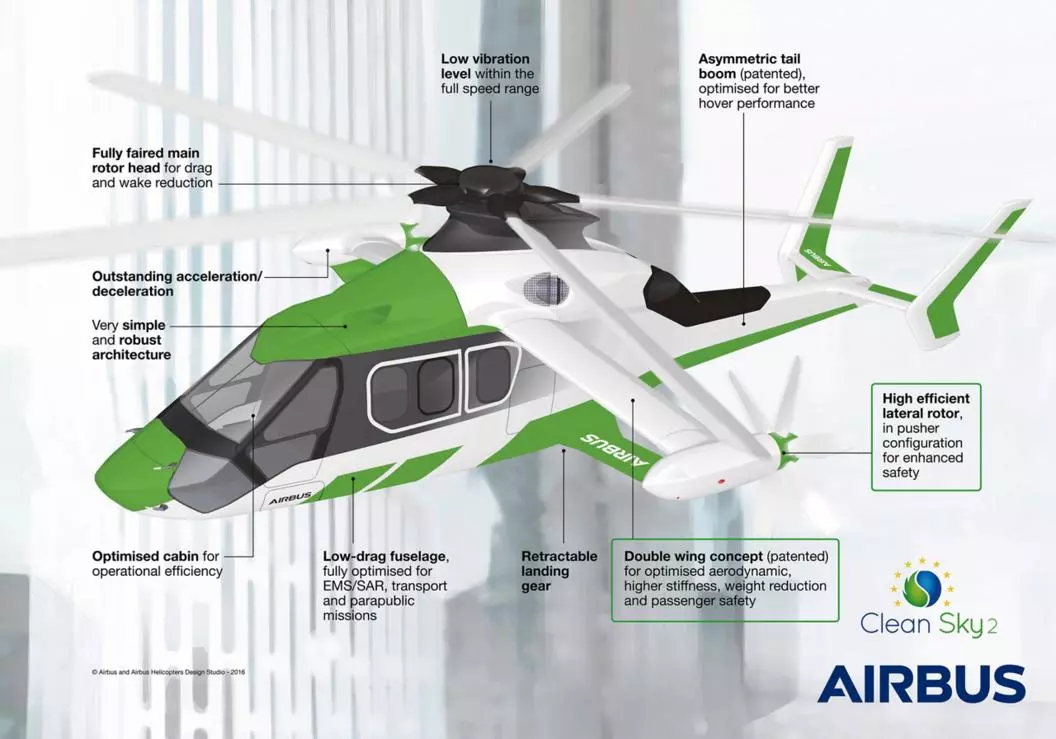
Airbus Racer: Pioneering High-Speed Helicopter Takes Flight
The Airbus Racer has taken to the skies, marking a significant milestone in the world of rotorcraft. This high-speed compound helicopter, developed by Airbus Helicopters, combines cutting-edge technology with a commitment to efficiency and sustainability. Let’s delve into the details of this remarkable aircraft.
The Maiden Flight

On April 25, 2024, the Airbus Racer soared above the tarmac in Marignane, France, embarking on its inaugural flight. Despite its brief 30-minute duration, this event signaled the beginning of a new era in aviation. The anticipation leading up to this moment was palpable, with engineers and workers meticulously preparing for the historic takeoff.
Airbus Racer: Innovative Design
The Racer boasts a hybrid design that elegantly addresses the technical challenges of high-speed helicopters. Its unique architecture includes:
- Special Fuselage Aerodynamics: The streamlined fuselage minimizes drag, allowing the Racer to cut through the air efficiently.
- Helicopter Rotor: The rotor system provides lift during takeoff and hover, ensuring stability.
- Fixed Wing: The addition of a fixed wing enhances aerodynamic performance during forward flight.
- Propulsive Propellers: These propellers contribute to the aircraft’s speed and agility.

Eco-Mode: Fuel Efficiency at Its Best
Fuel consumption and environmental impact were key considerations during the Racer’s development. The innovative Eco-Mode system, supported by the French Civil Aviation Authority (DGAC) and other partners, plays a pivotal role. During cruise flight, one of the two engines goes on standby, ready to restart instantly if needed. This approach reduces fuel consumption by 20%, striking a balance between speed and economy.
Noise Reduction
In addition to fuel efficiency, the Racer aims to minimize its noise footprint. By optimizing the wing’s performance and using trailing-edge flaps, the rotor’s load is reduced, resulting in quieter operation. This reduction in noise pollution benefits both passengers and the environment.
The Perfect Balance
Julien Guitton, head of the Racer program, emphasizes that the goal isn’t just raw speed but rather enhanced operational capabilities at a reasonable cost. The Racer achieves this delicate balance, offering impressive performance without compromising economic or environmental factors. It’s a winning formula that sets a new standard for high-speed helicopters.
Airbus Racer: Comparision with other High-Speed Helicopters
The Airbus Racer stands out as a high-speed helicopter demonstrator that aims to leverage increased speed to deliver significant added value for citizens and operators. Let’s explore how it compares to other high-speed helicopters:
- Speed and Efficiency:
- The Racer is optimized for a cruise speed of 400 km/h (216 knots), which is approximately 50% faster than conventional helicopters.
- Despite its slightly slower top speed compared to the Eurocopter X3 (which can reach 293 mph), the Racer more than compensates with its exceptional fuel efficiency. It consumes up to 15% less fuel per distance at 180 knots (333 km/h) than a helicopter flying at 130 knots (241 km/h).
- The innovative Safran Eco-Mode hybrid-electric system further contributes to fuel savings by allowing one of the two engines to switch to standby during cruise flight, resulting in additional savings of up to 30%.
- Cost Reduction:
- The Racer aims for a 25% cost reduction per distance compared to traditional helicopters.
- Its efficient design and reduced operating costs make it an attractive option for various missions.
- Environmental and Acoustic Footprint:
- The Racer not only excels in speed and efficiency but also focuses on environmental impact.
- Its dynamic configuration enables 15% less fuel burn per nautical mile at 180 knots compared to conventional helicopters.
- The distinct architecture of the Racer contributes to lowering its operational acoustic footprint, benefiting both passengers and the environment.
- Mission Versatility:
- The Racer intends to demonstrate the advantages of high speed across a wide range of missions, including:
- Emergency medical services: Where rapid response within the critical “golden hour” is crucial.
- Search and rescue operations: Speed can be a life-saving factor.
- Public service: Efficient transportation for various agencies.
- Commercial transportation: Swift and cost-effective travel.
- The Racer intends to demonstrate the advantages of high speed across a wide range of missions, including:
In summary, the Airbus Racer combines speed, efficiency, and mission versatility, making it a promising contender in the world of high-speed helicopters. Its innovative features and commitment to sustainability set it apart from the rest! 🚁✨
Airbus Racer: How does it handle Adverse Weather Conditions
The Airbus Racer has been designed to handle adverse weather conditions effectively, ensuring safety and reliability. Let’s explore how it copes with various challenges:
- Icing Conditions:
- Icing can significantly impact aircraft performance and safety. The Racer incorporates advanced anti-icing systems to prevent ice buildup on critical surfaces such as the rotor blades, wings, and tail.
- Electrically heated elements or hot air bleed systems are used to keep the rotor blades ice-free during flight.
- The Racer’s aerodynamic design also minimizes ice accumulation.
- Strong Winds and Gusts:
- High-speed helicopters like the Racer encounter strong winds during flight. Its stability and control systems are optimized to handle gusts effectively.
- The Racer’s fly-by-wire technology adjusts control surfaces rapidly to maintain stability even in turbulent conditions.
- Advanced sensors provide real-time data on wind speed and direction, allowing the pilot to make informed decisions.
- Low Visibility (Fog, Rain, Snow):
- The Racer is equipped with state-of-the-art avionics, including radar, lidar, and enhanced vision systems.
- Synthetic vision displays help pilots maintain situational awareness even when visibility is poor.
- The rotorcraft’s autopilot system assists in maintaining stable flight during reduced visibility.
- Thunderstorms and Lightning:
- Thunderstorms pose a significant risk to any aircraft. The Racer follows standard procedures to avoid thunderstorm cells.
- Lightning protection measures include conductive materials in critical areas and lightning diverters.
- The Racer’s composite materials are designed to dissipate electrical charges safely.
- Temperature Extremes:
- The Racer undergoes rigorous testing in extreme temperature conditions.
- Its systems are designed to operate efficiently in both hot and cold environments.
- Engine performance, avionics, and materials are carefully selected to withstand temperature variations.
- Rotor Icing and Blade De-icing:
- Rotor icing can degrade lift and stability. The Racer employs active blade de-icing systems.
- These systems use electrical heating or pneumatic boots to remove ice from the rotor blades.
- Sensors detect ice buildup, triggering the de-icing process automatically.
In summary, the Airbus Racer combines advanced technology, robust systems, and skilled piloting to handle adverse weather conditions. Its safety features ensure that it can operate effectively even when faced with challenging environments. 🚁❄️🌧️
Price of Airbus Racer
The Airbus Racer is an experimental high-speed compound helicopter developed by Airbus Helicopters. While it remains a demonstrator aircraft, it has garnered significant attention. The estimated cost to build the Racer was approximately €200 million. However, keep in mind that this figure represents the development cost, and if Airbus attracts enough interest from potential buyers, it might eventually become available for sale
Conclusion: Airbus Racer
As the Airbus Racer continues its flight envelope expansion over the next two years, we can expect further breakthroughs in rotorcraft technology. This remarkable aircraft represents a leap forward in aviation, proving that speed, efficiency, and sustainability can coexist harmoniously in the skies.
Stay tuned for more updates as the Racer redefines what’s possible in the world of helicopters!
Boeing vs Airbus: A Sky-High Showdown
Airbus A320 Wins Record Order for 292 Jets Worth US$ 37 Billion





